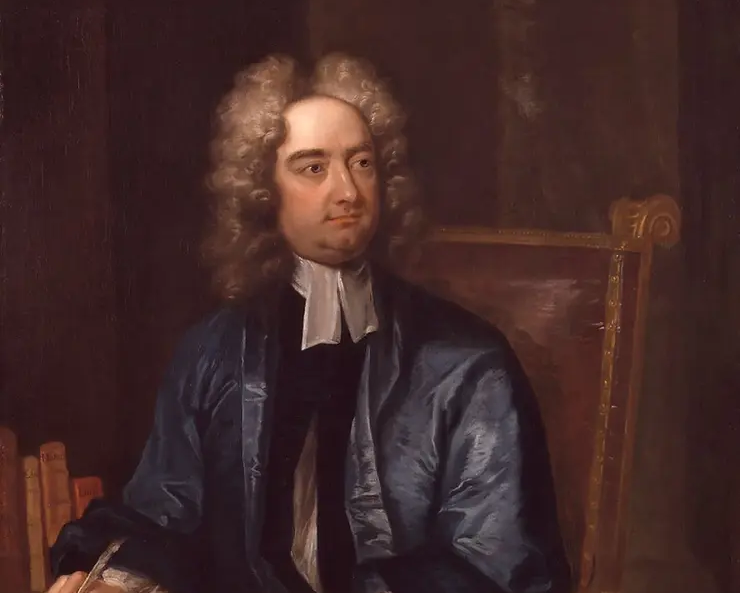Jonathan Swift: A Satirical Maverick Challenging the Status Quo.
From his biting satire to his profound insights into human nature, journey through the life of one of literature’s most captivating figures.
Early Life
Jonathan Swift’s early life was characterised by a series of challenges and upheavals that would profoundly shape his worldview and influence his writings.
Born on November 30, 1667, in Dublin, Swift was the second child and only son of Jonathan Swift Sr. and Abigail Erick. His father, a British-born lawyer, died just a few months before Swift’s birth, leaving his family financially strained. This early loss marked the beginning of a turbulent period for Swift.
At the age of six, Swift was sent to live with his uncle, Godwin Swift, a wealthy merchant in Dublin. Under his uncle’s care, Swift received a quality education, attending the Kilkenny Grammar School before enrolling at Trinity College in Dublin in 1682. His intellect and academic prowess quickly became evident, earning him scholarships and recognition among his peers. Despite his academic success, Swift’s time at Trinity was marked by financial difficulties and personal turmoil. In 1688, political unrest swept through Ireland, leading to the Glorious Revolution and the ousting of James II from the English throne. Swift, who had initially supported the Jacobite cause, found himself at odds with the new regime and faced uncertainty about his future.
In 1689, Swift left Ireland to seek his fortune in England, where he secured a position as secretary to Sir William Temple, a prominent diplomat and writer. Temple became a mentor to Swift, introducing him to influential circles and fostering his literary ambitions. During his time with Temple, Swift began writing essays, poetry, and satirical works, honing his distinctive style and voice. Despite his growing literary success, Swift’s relationship with Temple soured, leading him to return to Ireland in 1694. Over the next decade, Swift pursued a career in the clergy, eventually obtaining a position as Dean of St. Patrick’s Cathedral in Dublin in 1713.
Throughout his life, Swift grappled with feelings of displacement and alienation, never fully belonging to either Ireland or England. His experiences during his formative years instilled in him a deep sense of empathy for the marginalised and a fierce determination to advocate for social justice, an ethos that would permeate his later writings and define his legacy.
Career and Works
Jonathan Swift’s career and body of work are expansive and multifaceted, spanning various genres and themes that reflect his biting wit and commitment to social and political commentary. Swift’s mastery of satire is perhaps best exemplified in his iconic work, “Gulliver’s Travels”. Through the adventures of Lemuel Gulliver, Swift presents a scathing critique of human nature and politics. Each voyage to fantastical lands serves as a lens through which Swift examines different aspects of 18th-century European society, exposing its follies, vices and hypocrisies.

Swift was a prolific essayist and pamphleteer, using the medium to address contemporary issues and advocate for social reform. One of his most famous essays, “A Modest Proposal”, sarcastically suggests that impoverished Irish families should sell their children as food to the wealthy elite as a solution to economic hardship, a shocking and provocative critique of British economic policies in Ireland at the time.
Swift’s poetry showcases his versatility as a writer and his command of language. His early poem “The Battle of the Books” humorously depicts a literary skirmish between ancient and modern authors, while “Verses on the Death of Dr. Swift” provides a poignant reflection on mortality and legacy.
In addition to his sarcastic and essayistic writings, Swift produced numerous prose works that engaged with a wide range of subjects, from theology and philosophy to politics and history. His “A Tale of a Tub” is a satirical exploration of religious divisions and sectarianism, while “The Conduct of the Allies” offers a critique of British foreign policy during the War of the Spanish Succession.
Throughout his career, Swift was actively involved in political affairs, using his platform as a clergyman and writer to advocate for the interests of Ireland and its people. His “Drapier’s Letters” played a crucial role in rallying public opposition to the British government’s attempt to introduce a debased copper coinage in Ireland, earning him widespread acclaim and support. Swift was also a prolific journalist, contributing essays and articles to various newspapers and periodicals of his time. His writings often tackled pressing social and political issues, offering insight, analysis and, at times, biting satire.
Overall, Swift’s career and works reflect a deep engagement with the world around him, as well as a profound commitment to using literature for social change. His writings continue to resonate with readers today, serving as a testament to the enduring power of satire and the written word.

Personal life
Jonathan Swift’s personal life was marked by complexity and a sense of displacement, despite his towering literary achievements and public persona. Several key aspects shed light on his personal experiences.
Swift’s most significant personal relationship was with Esther Johnson, known as “Stella.” Their relationship has been the subject of much speculation and debate, with some historians suggesting that they were secretly married, while others view their bond as more platonic. Regardless of the nature of their relationship, Swift and Stella shared a deep emotional connection, evidenced by their extensive correspondence and Swift’s grief upon her death in 1728.
Throughout his life, Swift cultivated friendships with prominent figures, including Alexander Pope, John Gay, and Robert Harley. These friendships provided Swift with intellectual stimulation and emotional support, particularly during periods of personal and professional upheaval. Swift’s personal life was also marked by significant health struggles, including battles with Meniere’s disease, a condition affecting the inner ear, which caused him to experience vertigo and hearing loss. Additionally, Swift suffered from deteriorating eyesight in his later years, which greatly impacted his ability to read and write.
Despite his literary success and social connections, Swift often grappled with feelings of isolation and loneliness. His status as an outsider, both in Ireland and England, contributed to a sense of displacement and alienation. Swift’s writings frequently reflect themes of solitude and existential despair, revealing a deeply introspective and melancholic aspect of his personality.

Legacy and Reputation
Swift’s personal life and reputation have been the subject of ongoing scrutiny and interpretation. While he is revered as one of the greatest satirists and writers in the English language, his character and motivations continue to be debated by scholars and biographers. Some view Swift as a champion of social justice and a compassionate advocate for the oppressed, while others criticise him for his caustic wit and perceived misanthropy.
Swift’s personal life was characterised by a complex interplay of relationships and health struggles. Despite his achievements and influence, Swift’s inner life remains enigmatic, inviting continued exploration and interpretation by scholars and readers alike. His legacy extends far beyond his lifetime, leaving his mark on literature, politics, and social commentary. Several aspects contribute to his enduring influence and significance:
Swift played a significant role in the establishment of St. Patrick’s Hospital, which later became known as St. Patrick’s Mental Health Services. In 1745, Swift bequeathed a portion of his estate to establish a hospital for the mentally ill in Dublin. His generosity helped fund the construction of the hospital, which opened its doors in 1757.
St Patrick’s Hospital provided care and treatment for individuals suffering from mental illness at a time when such conditions were often stigmatised and poorly understood. Over the years, the hospital expanded its services and facilities, evolving into one of Ireland’s leading mental health institutions. Today, St. Patrick’s Mental Health Services continues to provide a range of psychiatric and mental health services, including inpatient care, outpatient services, and community-based programs. While Swift did not personally open the hospital during his lifetime, his philanthropic legacy played a crucial role in its establishment and ongoing mission to provide compassionate care for those in need.
Jonathan Swift’s enduring legacy encompasses a multifaceted impact on literature, politics, culture, and morality. His literary works, including “Gulliver’s Travels,” “A Modest Proposal,” and his satirical essays, are celebrated for their wit and insight. Swift’s mastery of satire and keen observation of human nature have inspired generations of writers and thinkers, shaping the development of English literature and influencing genres ranging from political satire to science fiction. Moreover, Swift’s political writings, such as his “Drapier’s Letters,” mobilised public opposition to British economic policies in Ireland, showcasing literature’s power as a tool for social and political change. His advocacy for Irish rights and critique of colonialism continue to resonate with movements for justice and equality worldwide.
Swift’s keen insight into societal flaws prompts reflection on issues of power and corruption, challenging entrenched beliefs and prejudices. Beyond literature and politics, Swift’s cultural legacy permeates popular culture, inspiring adaptations and reimaginings in various media forms. Furthermore, his intellectual rigour and moral integrity serve as a model for those committed to justice and social change, inspiring others to challenge injustice and advocate for a more equitable and compassionate world.

Here lies the body of Jonathan Swift, Doctor of Divinity and Dean of this Cathedral,
Where savage indignation can no longer lacerate his heart;
Go traveller and imitate if you can, this dedicated and earnest champion of liberty
He died on the 19th October 1745, aged 78 years old.

